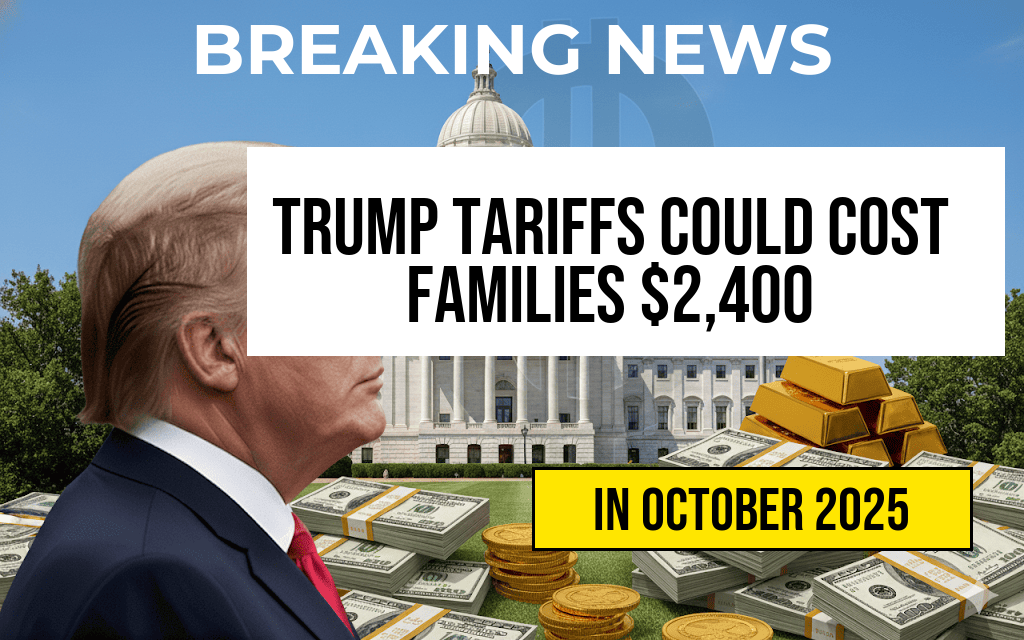Recent analysis suggests that the ongoing trade policies under the Trump administration, particularly the implementation of tariffs, could result in an additional $2,400 annually being added to the average American family’s expenses. Dubbed the “Turbulence Tax” by some economists, these tariffs aim to protect domestic industries but may inadvertently raise costs for consumers across a broad range of goods. While proponents argue that tariffs bolster U.S. manufacturing and job creation, critics warn that the increased prices could strain household budgets, especially for lower- and middle-income families. This article examines the scope of the tariffs, their projected impact on household spending, and the broader economic implications, drawing on recent studies and expert insights.
Understanding the Scope of Trump’s Tariffs
What Are These Tariffs?
Tariffs are taxes imposed on imported goods, making foreign products more expensive and thereby encouraging consumers to buy domestically produced items. Under President Trump’s trade policies, tariffs have been levied on a wide array of Chinese imports, ranging from electronics and machinery to consumer goods. The goal has been to address trade imbalances and protect American manufacturing, but these measures also ripple through supply chains and retail prices.
Key Sectors Affected
- Electronics and Appliances: Tariffs on Chinese electronics have increased costs for manufacturers and consumers alike.
- Furniture and Home Goods: Imported furniture faces higher taxes, impacting retail prices.
- Clothing and Textiles: Tariffs have raised the cost of apparel, which often relies on imported fabrics and finished products.
Projected Economic Impact on Families
Estimating the Cost Increase
| Consumer Category | Average Additional Cost |
|---|---|
| Households | $2,400 |
| Single Adults | $600 |
| Families with Children | $2,400 |
These estimates stem from comprehensive analyses conducted by economic research firms, which account for increased prices across various consumer goods and services. The figure of $2,400 represents the average annual additional burden per family, though actual impacts can vary based on household consumption patterns.
Major Cost Drivers
- Retail Goods: Increased costs on electronics, clothing, and household items.
- Food Products: Tariffs on agricultural imports may lead to higher grocery bills.
- Automobiles: Tariffs on auto parts and vehicles can inflate prices for new and used cars.
Economic and Political Perspectives
Supporters’ Viewpoint
Advocates argue that tariffs serve as leverage to renegotiate trade agreements, safeguard American jobs, and bolster domestic industries. They claim that the initial costs are an investment in long-term economic resilience. Some policymakers believe that protecting manufacturing sectors will lead to a more balanced trade relationship and reduce reliance on foreign imports.
Critics’ Concerns
Opponents highlight that tariffs often lead to higher consumer prices, which disproportionately affect lower-income households. They warn that retaliatory tariffs by other countries could hurt exports, potentially leading to job losses in sectors reliant on international markets. Economists also caution that tariffs can cause market volatility and disrupt global supply chains, undermining economic stability.
Broader Economic Implications
Supply Chain Disruptions
The imposition of tariffs has prompted companies to reconsider their sourcing strategies, often leading to increased costs for goods and delays in production. A report by the Wikipedia page on global supply chains underscores how tariffs can cause ripple effects across industries, affecting everything from manufacturing to retail.
Inflationary Pressures
Higher prices for imported goods contribute to overall inflation, which can erode purchasing power and impact savings. The Federal Reserve and other economic bodies monitor these trends closely, as sustained inflation can lead to higher interest rates and tighter monetary policy.
Looking Ahead
As trade tensions continue, families and businesses remain uncertain about future costs. While some industries may benefit from reduced overseas competition, the consumer sector appears to bear the brunt of tariff-induced price hikes. Policymakers face the challenge of balancing protectionist strategies with the need to keep everyday costs manageable for American households.
Frequently Asked Questions
What are the main effects of the ‘Turbulence Tax’ on family budgets?
The ‘Turbulence Tax’ resulting from Trump tariffs can add approximately $2,400 annually to a typical family’s expenses, impacting household budgets by increasing costs on imported goods and goods affected by trade policies.
Which products are most affected by the tariffs discussed in the article?
The tariffs primarily impact consumer electronics, automobiles, steel, and aluminum, leading to higher prices for these imported goods and consequently increasing overall household expenses.
How might these tariffs influence the prices of everyday items?
These tariffs tend to raise the costs of imported goods, which can lead to higher retail prices for everyday items such as groceries, clothing, and household supplies, potentially increasing your family’s monthly spending.
What strategies can families use to mitigate the financial impact of these tariffs?
Families can consider shopping locally, seeking alternative brands, or adjusting their consumption habits to minimize the effect of increased prices caused by the ‘Turbulence Tax’ and tariffs.
Are there any broader economic implications of the tariffs mentioned in the article?
Yes, the tariffs can lead to trade tensions, supply chain disruptions, and potential inflationary pressures, which may further contribute to the additional costs reflected in household budgets and overall economic stability.

Leave a Reply